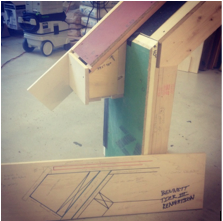With code updates on the horizon (Title 24 2019 takes effect January 1, 2020), many of our clients are beginning to focus on how to design to the new “Zero Net Energy” (ZNE) requirements for residential construction.
We recently presented a summary of residential energy code changes for Santa Barbara’s AIA, and we’ll be presenting for AIA Central Coast (SLO) on June 19. As with past code cycles, there are prescriptive and performance paths for compliance, with the former serving as baseline for the latter.
Jennifer Rennick, Certified Energy Analyst and our in-house energy modeling specialist, noted that, “Envelope improvements and photo-voltaic (PV) energy systems will be required, as expected. Less obvious is that the new code takes into account that our peak demand is now 2 PM – 8 PM, so high energy demand during those hours will take a bigger hit than in the current code.”
Within the prescriptive path, the code offers options for new HVAC and water heating systems that help projects comply with more demanding energy use rules. Notable is that Quality Insulation Installation (QII) will be required for the prescriptive path, but remain a credit under the performance method.
For projects that use the performance approach, an Energy Design Rating (EDR) will need to be calculated. One part of the rating is energy efficiency, the other incorporates the addition of a renewable energy system.
Of course, energy efficiency goes hand in hand with high performance assemblies, a specialty of In Balance’s Mike Horgan, a licensed contractor and Certified Passive House Consultant. He recommends EDPM gaskets and air-tight adhesives for sealing sill plates, a common and pervasive location for air leakage. He emphasized, “From sealing, to insulation, to waterproofing, details that effectively convey to contractors how to construct air-tight and vapor permeable assemblies will be essential.”
Mike finds that constructing models of details that will live onsite, such as this one demonstrating an applied eave detail for a continuous “red line” exterior envelope, facilitate communication and lead to better building outcomes.
Two online resources that can be helpful for visualizing examples of high performance assemblies include:
· Foundation Design Handbook by Oak Ridge National Laboratory
· Illustrated Guide: R22+ Effective Walls in Wood-Frame Construction in British Columbia
Interested in ZNE detail consulting or constructability? We offer personalized sessions at your office, online, or on the job site (with props!) to discuss your project specifics.
For Santa Barbara projects, reach out to Michelle Zimney. In San Luis Obispo and surrounding areas, please contact Jennifer Rennick or Mike Horgan.




